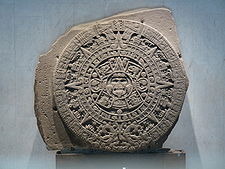- Aztec calendar stone
-
"Sun stone" redirects here. For the gemstone, see Sunstone.
Mexica Sun Stone 
Material Basalt Discovered 17 December 1790 at El Zócalo, Mexico City Present location National Museum of Anthropology, Mexico City The Aztec calendar stone, Mexica sun stone, Stone of the Sun (Spanish: Piedra del Sol), or Stone of the Five Eras, is a large monolithic sculpture that was excavated in the Zócalo, Mexico City's main square, on December 17, 1790.[1] It was discovered whilst Mexico City Cathedral was being repaired.[2] The stone is around 12 foot across and weighs about 24 tons.[3]
The exact purpose and meaning of the stone is unclear. However archaeologists and historians have proposed a number of theories and it seems likely that there are many aspects to the stone.[4]
One aspect of the stone is its religious significance. One theory is that the face at the centre of the stone represents Tonatiuh, the Mexica god of the sun. It is for this reason that the stone became known as the "sun stone". Richard Townsend proposed a different theory, claiming that the figure at the centre of the stone actually represents Tlaltecuhtli, the Mexica sea or earth monster who features in Mexica creation myths.[4]
Another aspect of the stone relates to time, hense the name "calendar stone". Some of the circles of glyphs are the glyphs for the days of the month. Further, some of the symbols may represent the five ages that the Mexica believed the earth had passed through.[4][2]
Yet another aspect of the stone may be its geographic significance. The four points may relate to the four corners of the earth or the cardinal points. The inner circles may express space as well as time.[5]
Moreover, there is the political aspect of the stone. It may have been intended to show Tenochtitlan as the centre of the world and therefore as the centre of authority.[6]
Despite its being known as a "calendar stone," modern archaeologists such as those at the National Anthropology Museum in Mexico City, at which the stone is housed, believe it more likely to have been used primarily as a ceremonial basin or ritual altar for gladiatorial sacrifices, than as an astrological or astronomical reference.[citation needed]
References
- ^ Florescano, Enrico (2006). National Narratives in Mexico. Nancy T. Hancock (trans.), Raul Velasquez (illus.) (English-language edition of Historia de las historias de la nación mexicana, ©2002 [Mexico City:Taurus] ed.). Norman: University of Oklahoma Press. ISBN 0-8061-3701-0. OCLC 62857841.
- ^ a b Aztec Civilization
- ^ The Aztec Sun Stone
- ^ a b c K. Mills, W. B. Taylor & S. L. Graham (eds), Colonial Latin America: A Documentary History, 'The Aztec Stone of the Five Eras', p. 23
- ^ K. Mills, W. B. Taylor & S. L. Graham (eds), Colonial Latin America: A Documentary History, 'The Aztec Stone of the Five Eras', pp. 23, 25
- ^ K. Mills, W. B. Taylor & S. L. Graham (eds), Colonial Latin America: A Documentary History, 'The Aztec Stone of the Five Eras', pp. 25-6
Sources
- K. Mills, W. B. Taylor & S. L. Graham (eds), Colonial Latin America: A Documentary History, 'The Aztec Stone of the Five Eras'
- León y Gama, Antonio de. Descripción histórica y cronológica de las dos piedras: que con ocasión del empedrado que se está formando en la plaza Principal de México, se hallaron en ella el año de 1790. Impr. de F. de Zúñiga y Ontiveros, 1792. An expanded edition, with descriptions of additional sculptures (like the Stone of Tizoc), edited by Carlos Maria Bustamante, published in 1832. There have been a couple of facsimile editions, published in the 1980s and 1990s.
- Solis, Felipe. "La Piedra del Sol." Arqueologia Mexicana 7(41):32-39. Enero - Febrero 2000.
External links
Categories:- Aztec artifacts
- Stones
Wikimedia Foundation. 2010.
